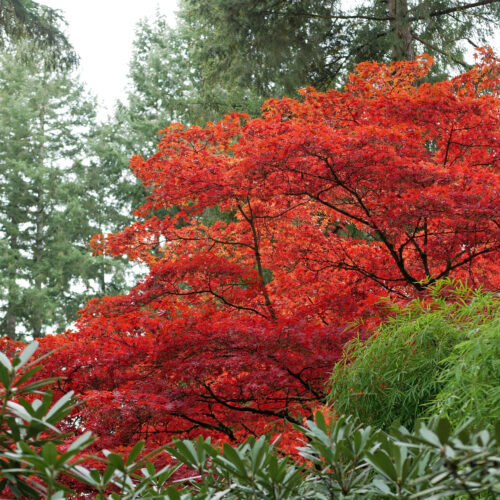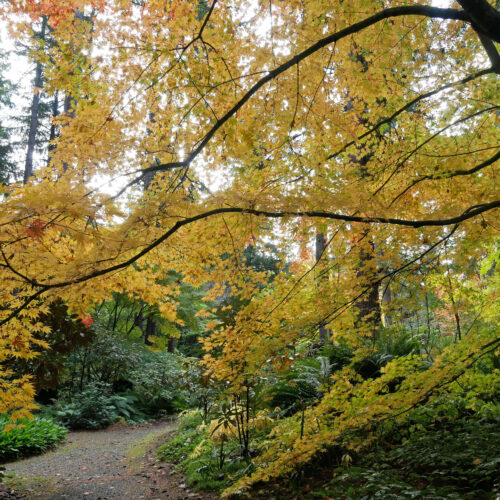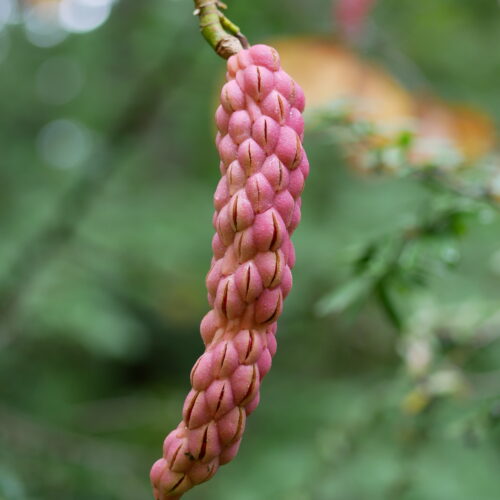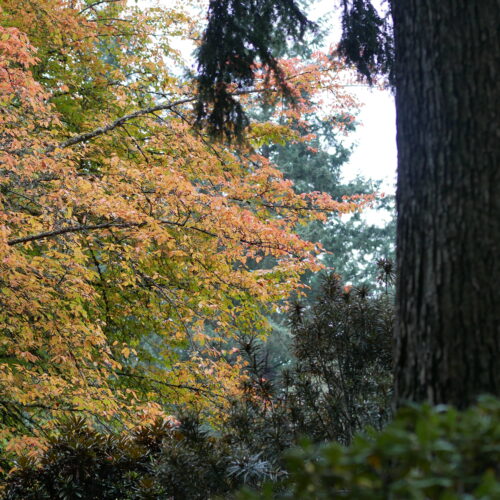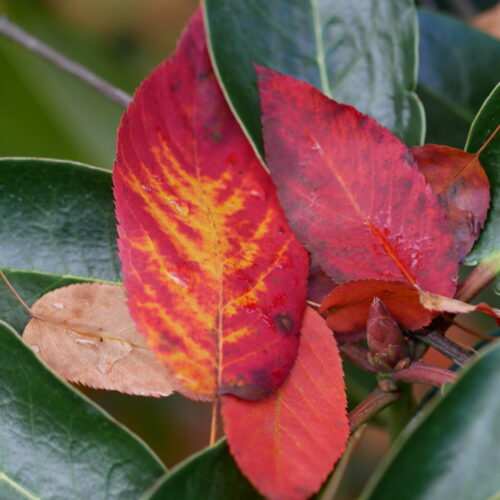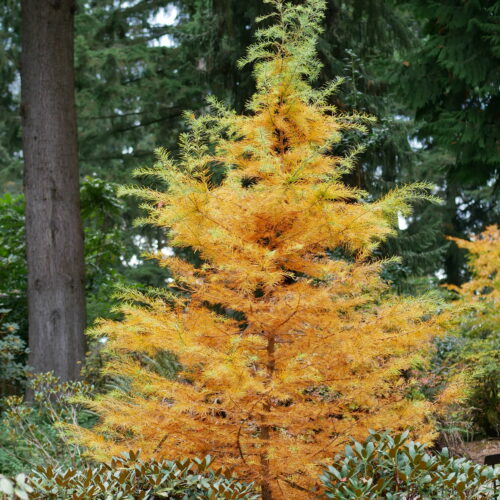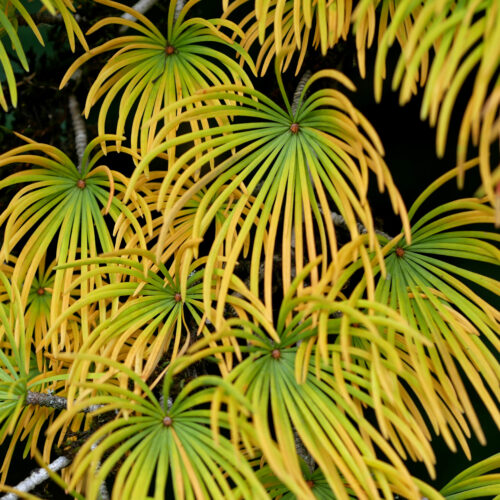By RSBG Horticulturist and Assistant Curator Will Clausen
October is here, and by now, the days are getting short, the sky cloudy and often heavy with rain, and in the garden, we start to see colors popping up where before everything was green. The month of fall color is finally upon us, a time of year that rivals spring for beauty in the garden. Just like our flowers, the fall color comes in waves. Early and mid-October are nice, but things ramp up toward the end of the month and into early November.
Upper Woodland
The stand of magnolias that offer shady relief in the summer are now shedding their large leaves. Though the color, in shades of tan and dull yellow, isn’t exactly breathtaking, it is fantastic to see how they pile up on the ground and to pick one up to get a sense of their size. Look up in the trees for large red fruiting structures appearing like cones. Small slits form throughout the fruit to reveal each bright red seed that looks like little pieces of candy. They are certainly a treat for birds and squirrels. Following the path downhill, walk under the sweeping branches of Acer sieboldianum, bright yellow later in the month and into early November. This is one of a handful of Japanese maples that brighten up this part of the garden, including the distinct small-leaved A. palmatum ‘Kurui Jishi’. Look for licorice fern (Polypodium glycyrrhiza) growing on stumps and logs. While their fronds tend to disappear in the summer as the plants go dormant due to a lack of water, new fronds have emerged by October and are relishing the cool, wet weather.
Lawn
The area around the lawn offers some of the best fall colors to be found in the garden. Tall deciduous trees ring the lawn, receiving ample sunlight, which triggers intense autumnal color. Among these trees are several old Alleghany serviceberry (Amelanchier laevis), which range in color from red to orange. These trees are among the earliest to color up for us, which, unfortunately, means they are also among the first to start dropping their leaves. By the end of October, when much of the garden has reached a bright peak, they are usually already bare. Two large red maples (Acer rubrum) stand tall over the lower end of the lawn. The leaves toward the tips of their highest branches start striking out in fall color by late September, and as October progresses, they slowly transform into two of the loudest trees in the garden, bright red-orange-yellow and brilliant. Also around the lawn is a small collection of deciduous conifers, an exciting group of plants that appear evergreen in the summertime but then turn color in the fall, drop their needles in the winter, and produce new foliage in the spring. A lone dawn redwood (Metasequoia glyptostroboides) grows in the lawn, a fast grower that turns an attractive rusty orange color later in the month and into November. Earlier to color up are two golden larch (Pseudolarix amabilis) that flank either side of the top of the lawn. These turn a much richer butterscotch yellow and are gorgeous plants. Near the gazebo, a wiry old European larch (Larix decidua) is the lone representative of that genus in the garden, turning yellow usually into early November. Scanning down the edge of the lawn, one of the richest reds in the garden can be found in Acer palmatum ‘Osakazuki’. This tree stands out all the more for being surrounded by dark green rhododendron and bamboo. This is my favorite tree to look at when it is at its best, sometimes stopping in my tracks and causing me to forget what I had been planning to do.
Azalea Collection
Azaleas are the outstanding fall color performers in the Rhododendron world, so a visit to the garden in the fall is complete with a walk through the Azalea Collection. The fall-blooming Franklin tree (Franklinia alatamaha), a botanical curiosity and good autumnal plant, sits at one of the entrances. Last seen in the wild in the early 1800s and believed to be extinct, it was only ever known from an isolated occurrence near the mouth of the Alatahama River in coastal Georgia. It is a strangely beautiful plant with large white flowers that usually occur at the same time as its leaves turn red. Even though it may no longer exist in the wild, they will live on in gardens. Walking down the path, pass by a succession of azaleas such as flame azalea (Rhododendron calendulaceum), mountain azalea (R. canescens), and early azalea (R. prinophyllum) among many others. Look for errant fall flowers on the azaleas. Usually, one or two plants have been tricked by the cool weather into blooming for a second time. Although they don’t usually bloom profusely, seeing flowers this time of year is very special. Above them is a strikingly yellow American mountain ash (Sorbus americana). At the far end of the bed, we are lucky enough to have one of the many sourwoods (Oxydendrum arboreum) in the garden.
Wander the rest of the garden to see many other autumnal highlights scattered among the evergreen rhododendrons. The garden will be lit with color through the end of the month and into early November when the first touches of winter can be felt.
- Acer palmatum ‘Osakazuki’
- Acer sieboldianum
- Magnolia sprengeri ‘Diva’
- Amelanchier laevis
- Amelanchier laevis leaves on Rhododendron campanulatum
- Pseudolarix amabilis
- Pseudolarix amabilis
- Rhododendron prinophyllum

